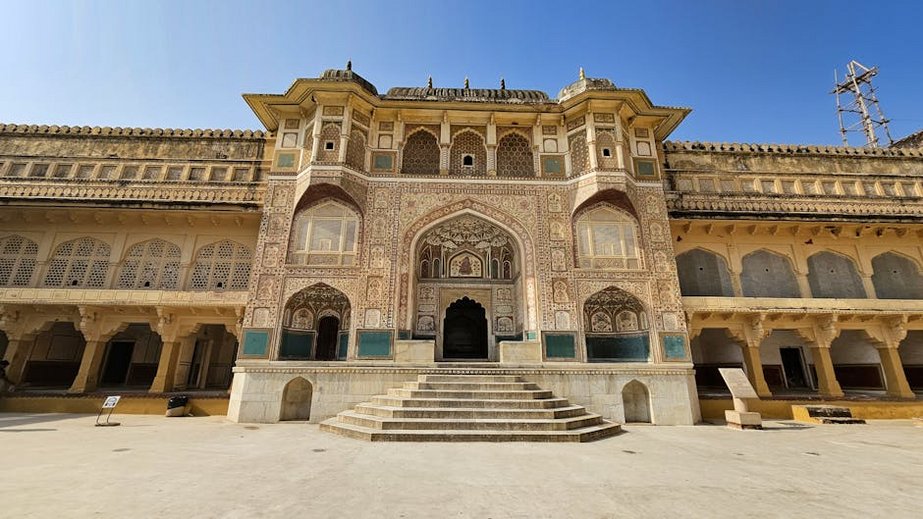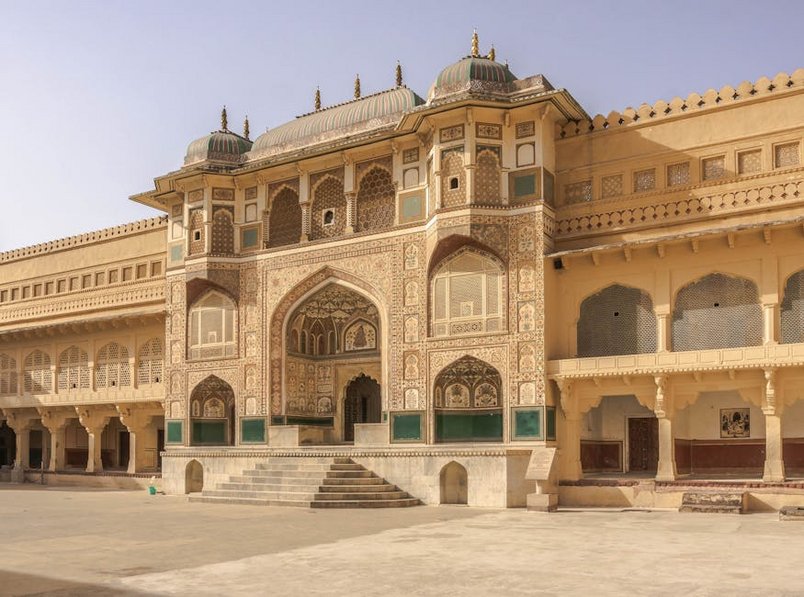Jaipur Amber Fort: A Majestic Journey Through Rajasthan’s Royal History
Exploring the magnificent Jaipur Amber Fort is like stepping into a living history book where every wall whispers tales of Rajput valor, Mughal influence, and royal grandeur. Perched majestically on a hilltop overlooking Maota Lake, this UNESCO World Heritage Site represents one of India’s most spectacular architectural achievements, blending Hindu and Muslim styles into a breathtaking fortress-palace complex. As you approach through the rugged Aravalli hills, the fort’s honey-colored sandstone walls create a stunning contrast against the blue sky, offering a visual spectacle that stays with you long after your visit. The journey to Amber Fort itself is an experience, whether you choose to ascend on elephant back like royalty of old or hike up the winding pathways while taking in panoramic views of Jaipur. Inside, you’ll discover a labyrinth of palaces, temples, gardens, and halls that showcase the opulence of Rajasthan’s Kachhwaha rulers, with intricate mirror work, exquisite paintings, and elaborate carvings that demonstrate incredible craftsmanship. Visiting Amber Fort isn’t just checking off another tourist attraction—it’s immersing yourself in centuries of history, culture, and architectural brilliance that defines Rajasthan’s royal heritage.
Jaipur Amber Fort Essential Information – Planning Your Visit
Before embarking on your Amber Fort adventure, understanding the practical details will significantly enhance your experience. The fort complex spans approximately 4 square kilometers and requires at least 3-4 hours to properly explore, though history enthusiasts might want to allocate more time. The architecture follows the Rajput style with strong Mughal influences, evident in the delicate marble work, expansive courtyards, and sophisticated water management systems that were revolutionary for their time. What makes Amber Fort particularly fascinating is how it functions both as a defensive structure with massive gates and ramparts while simultaneously serving as a luxurious royal residence with exquisite living quarters. The temperature can vary dramatically between the sunny courtyards and shaded interiors, so dressing in layers proves practical. During peak season, the fort receives thousands of visitors daily, making early morning or late afternoon visits more comfortable for photography and contemplation without crowds obstructing your views of this architectural masterpiece.
Historical Significance – What You Need to Know
- Built by Raja Man Singh I in 1592 and expanded by successive rulers over 150 years, representing the pinnacle of Rajput-Mughal architecture
- Served as the capital of the Kachhwaha Rajputs until Jaipur city was established in 1727, making it the political and cultural heart of the region
- The fort’s strategic location provided military advantage while its design incorporated sophisticated cooling systems for Rajasthan’s extreme climate
- Budget travelers can experience Amber Fort for approximately $15-20 per person including entry fee, audio guide, and shared transportation from Jaipur
- Mid-range visitors might budget $40-60 covering guided tour, private transportation, meals, and additional experiences like elephant rides
- Luxury experiences including private guides, photography sessions, and special access can range from $100-200 per person
- Rajasthan Tourism Development Corporation Official Guide
- UNESCO World Heritage Centre Listing
Architectural Highlights – Key Details
Amber Fort’s architecture demonstrates brilliant adaptation to both defensive needs and luxurious living. The main entrance through Suraj Pol (Sun Gate) leads to Jalebi Chowk, where returning armies would display their war spoils. The division into four main sections—each with separate entry gates—reflects careful planning for security and function. The Diwan-i-Aam (Hall of Public Audience) features intricately carved pillars and latticed galleries, while the Diwan-i-Khas (Hall of Private Audience) showcases exquisite mirror work and floral patterns. The Sheesh Mahal (Mirror Palace) represents the fort’s most photographed area, with countless tiny mirrors arranged in patterns that would glitter under candlelight. What many visitors miss are the underground passages connecting Amber Fort to Jaigarh Fort, designed as escape routes during sieges—a testament to the builders’ strategic planning that combined beauty with practicality.

Jaipur Amber Fort Planning Your Trip – Best Times and Budgeting
Planning your Jaipur Amber Fort visit requires consideration of seasonal weather patterns, cultural events, and practical logistics. The fort operates from 8:00 AM to 5:30 PM daily, with extended hours during special events and festivals. November through February offers the most pleasant weather with daytime temperatures around 68-75°F (20-24°C), though mornings and evenings can be chilly enough for a light jacket. March to June brings increasing heat, with temperatures often exceeding 104°F (40°C), making early morning visits essential for comfort. July to September sees monsoon rains that can create spectacular photo opportunities with dramatic skies but might make pathways slippery. The fort hosts sound and light shows in the evenings that beautifully narrate its history against the illuminated backdrop—an experience worth scheduling into your itinerary. Considering crowd patterns, weekdays generally see fewer visitors than weekends, and arriving right at opening time allows you to explore the most popular areas before tour groups arrive.
Best Time to Visit Jaipur Amber Fort
The ideal time for visiting Amber Fort is between October and March when Rajasthan’s climate is most comfortable for exploration. During these months, temperatures range from 50-80°F (10-27°C) with minimal rainfall, allowing you to comfortably climb the ramparts and explore outdoor areas without extreme heat discomfort. January particularly offers clear skies perfect for photography, though early mornings might require warm layers. The winter months also coincide with several cultural festivals like Diwali and Holi, where the fort often hosts special events and decorations. If visiting during summer (April-June), plan your arrival before 10:00 AM to avoid peak heat, and carry sufficient water as the climb and extensive walking can be dehydrating. Monsoon season (July-September) creates lush green surroundings and dramatic cloud formations that make stunning photographs, though some areas might be temporarily closed during heavy rainfall.
Budget Planning and Costs
Essential Preparation Checklist
Preparing adequately for your Amber Fort visit ensures a comfortable and enriching experience. Wear sturdy walking shoes with good grip as the stone pathways can be uneven and require considerable walking—you’ll easily cover 3-5 miles exploring the entire complex. Lightweight, breathable clothing that covers shoulders and knees is recommended both for sun protection and cultural respect, though scarves are available for purchase at entrance shops. Carry a refillable water bottle as hydration stations are available throughout the fort. Photography enthusiasts should bring wide-angle lenses for capturing expansive courtyards and telephoto lenses for architectural details. Downloading a map or audio guide app beforehand helps navigation, though official guides are available at entrance. If visiting during summer, sunscreen, hat, and sunglasses are essential, while monsoon visitors should pack rain protection and plastic bags for electronics.
Jaipur Amber Fort Top Attractions and Activities – Must-See Highlights
Amber Fort’s vast complex offers countless remarkable areas to explore, each with unique historical and architectural significance. The ascent to the fort itself presents a choice between traditional elephant rides (though ethical considerations apply) or walking up the ramped pathway that offers spectacular valley views. Upon entering through the magnificent Sun Gate, you arrive at Jalebi Chowk, the main courtyard where soldiers once gathered and celebrations occurred. The Diwan-i-Aam (Hall of Public Audience) immediately impresses with its double row of columns and latticed galleries where royal women could observe proceedings unseen. However, the true masterpiece is the Sheesh Mahal (Mirror Palace), where thousands of tiny mirrors embedded in walls and ceilings create magical light effects—especially captivating when guides demonstrate how a single candle could illuminate the entire room. The Zenana (women’s quarters) reveals fascinating insights into royal life with its separate apartments arranged around a common garden, designed so the king could visit any wife without others knowing. Don’t miss the Sila Devi Temple near the entrance, dedicated to the goddess of war, with its stunning silver doors and intricate marble work.
Must-See Highlights
Among Amber Fort’s countless treasures, several highlights deserve special attention and time. The Ganesh Pol (Ganesh Gate) serves as the entrance to the private palaces, featuring stunning frescoes and lattice work that represent Rajput art at its finest. The Sukh Niwas (Hall of Pleasure) demonstrates ingenious ancient air conditioning through a water channel that cooled the space via breeze manipulation—a remarkable engineering feat. The Baradari pavilion in the garden offers perfect photo opportunities with its twelve-door design and panoramic views of the surrounding hills and lake. For photography enthusiasts, the best light occurs during golden hour when the honey-colored sandstone glows warmly against the sky. The sound and light show in the evenings narrates the fort’s history in multiple languages against the illuminated backdrop, creating a magical atmosphere worth experiencing. Many visitors overlook the ancient stepwell (baoli) near the fort’s entrance, which provided water security during sieges and represents fascinating hydraulic engineering.
Hidden Gems and Local Favorites
Beyond the main tourist routes, Amber Fort conceals several lesser-known spots that offer quieter contemplation and unique perspectives. The secret passages connecting to Jaigarh Fort remain partially accessible and provide glimpse into the strategic planning of Rajput defenses. The little-visited Lakshmi Vilas garden features beautiful flower beds and offers peaceful respite from crowds with excellent views of the valley. Local guides often know about the hidden balcony near Sheesh Mahal that provides a unique angle for photography without people in your shots. The traditional puppet shows occasionally performed in smaller courtyards offer cultural immersion rarely found in guidebooks. For the best local experience, visit the small cafes in Amber village at the fort’s base where you can enjoy masala chai while watching artisans create traditional handicrafts. Early morning visitors might witness local prayers at the ancient temple just outside the fort walls, providing authentic cultural interaction away from tourist crowds.
Jaipur Amber Fort Practical Travel Information – Transportation and Accommodation
Reaching and staying near Amber Fort requires understanding local transportation options and accommodation choices that suit different budgets and preferences. The fort lies approximately 7 miles (11 kilometers) from central Jaipur, requiring 30-45 minutes travel time depending on traffic conditions. Auto-rickshaws offer the most flexible transportation with fares around $5-8 for roundtrip including waiting time, though negotiating firmly beforehand is essential. Taxis and ride-sharing services provide more comfort at $10-15 roundtrip, while local buses cost under $1 but involve multiple changes and crowded conditions. Many visitors combine Amber Fort with visits to nearby Jaigarh Fort and Nahargarh Fort, making hiring a driver for half-day ($20-30) economically sensible. The area around Amber Fort features limited accommodation options, with most visitors staying in Jaipur city proper where choices range from budget hostels to heritage hotels. However, several boutique properties in the surrounding countryside offer unique experiences with fort views and traditional hospitality.
| Accommodation Category | Options/Features | Price Range (USD per night) |
|---|---|---|
| Budget Guesthouses | Basic amenities, shared facilities, local meals | $15-30 |
| Mid-range Hotels | Air conditioning, private bathrooms, swimming pool | $40-80 |
| Heritage Properties | Historical buildings, traditional decor, cultural activities | $100-200 |
| Luxury Resorts | Fort views, spa services, fine dining, private tours | $250-500+ |


